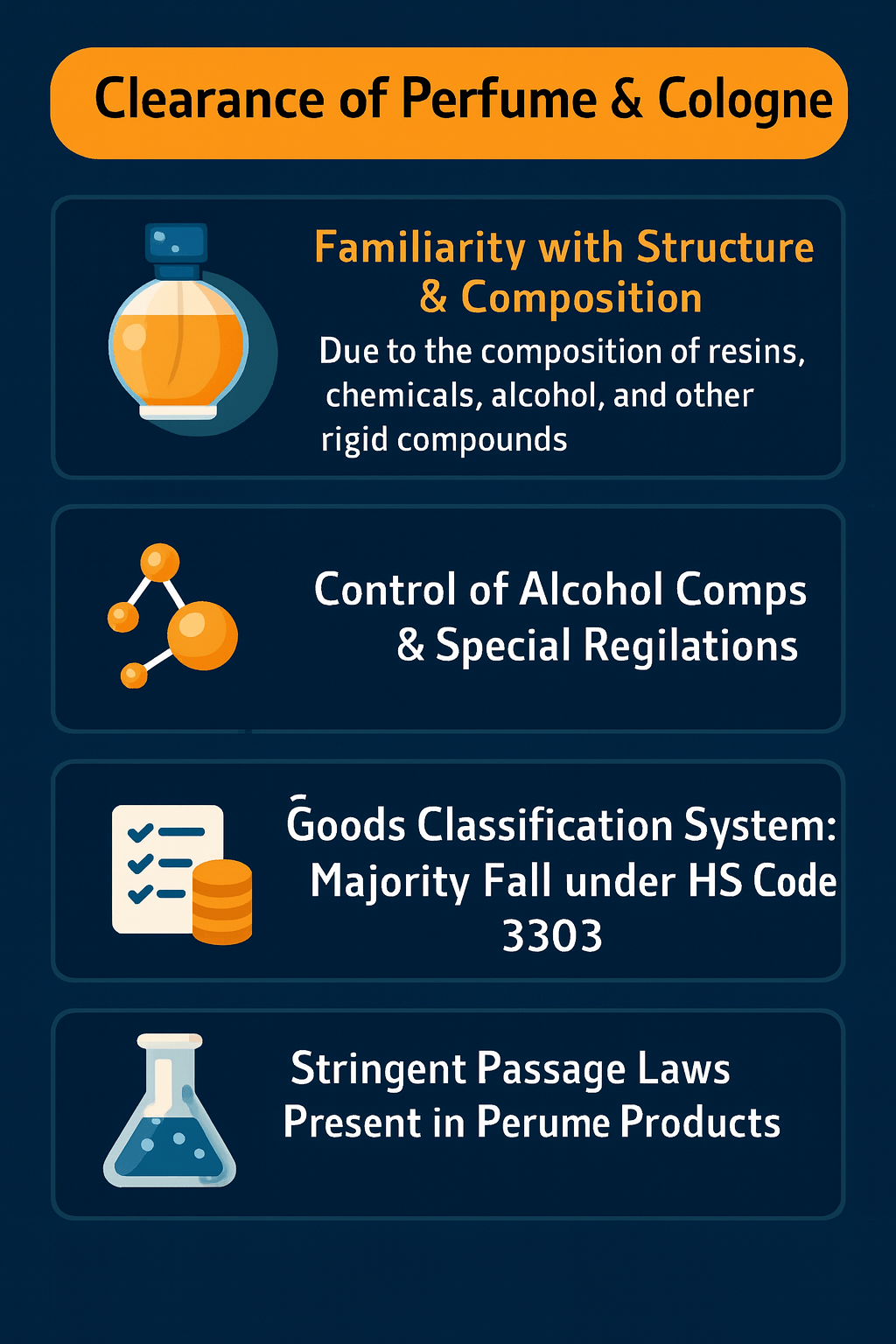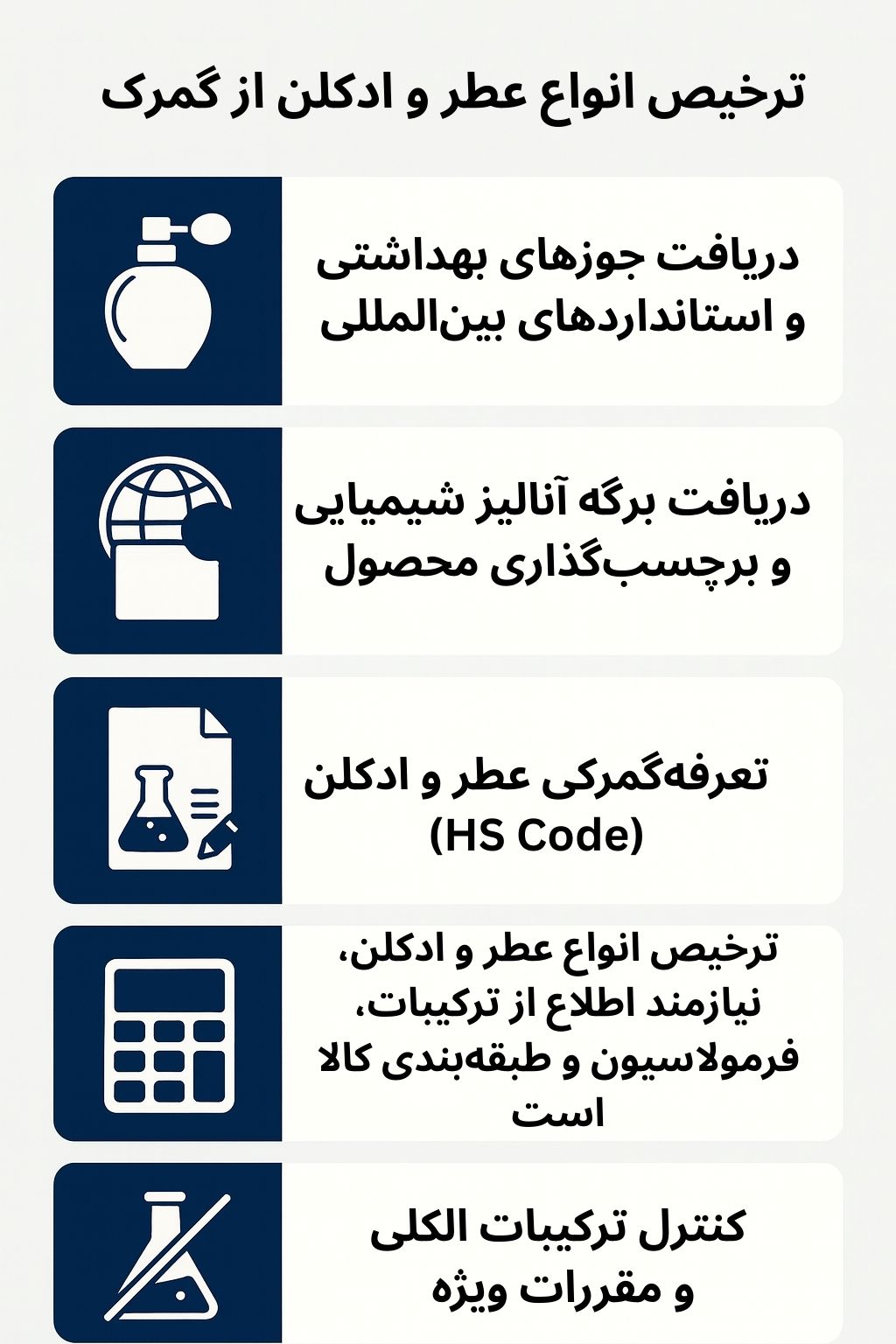Customs Clearance of Various Perfumes and Colognes (HS 3303 + Permits and Documents)
To estimate the time and cost of perfume and cologne clearance, contact the experts at Saba Tarkhis.
Instant & Free Consultation
Familiarity with the Structure and Ingredients of Perfume and Cologne
Ingredients and Structure of Perfume and Cologne
Specialized Steps for Customs Clearance of Perfume and Cologne
1) Obtaining Health Permits and International Standards
2) Placing the Order in the National Trade System and the Iranian Customs EPL System
3) Obtaining the Chemical Analysis Sheet and Standard Product Labeling
4) Customs Tariff for Perfume and Cologne (HS Code)
5) Control of Alcoholic Ingredients and Special Regulations
6) Providing the Invoice and Import-Related Documents
Exporting Countries and Trade Flow
Iran is one of the largest importers of perfume and cologne in the Middle East. France, as one of the largest producers of luxury perfumes in the world, is considered the main exporter of these products to Iran. Other exporting countries to Iran include Italy, Germany, the United Arab Emirates, and Turkey, which, due to geographical proximity and favorable trade relations, supply part of Iran’s market.
With its rich natural resources and aromatic plants, Iran is active in the production of plant essences and local perfumes. Some neighboring countries such as Iraq, Afghanistan, Azerbaijan, and Armenia are among the main buyers of Iranian-produced essences and perfumes.
The import volume of perfume and cologne into Iran reaches about 30 to 50 million USD annually, and due to high demand for luxury global brands, this amount is usually increasing. In contrast, the export volume of Iranian-produced essences and plant-based perfumes is relatively lower and is estimated at a few million USD.
The perfume and cologne industry is one of the best-selling and most profitable industries worldwide, with consistently high consumer demand. This global market is rapidly growing due to the popularity of perfumes around the world and their high demand. On average, the industry’s turnover in recent years has exceeded 50 billion USD, and it is predicted to rise to over 70 billion USD by 2028. High demand for luxury products, consumers’ interest in online purchasing, and increased use of niche and rare fragrances are among the reasons driving this growth.
Exports of perfume and cologne are primarily led by countries with long experience and strong infrastructure in producing these products. At the top is France. Thanks not only to its rich perfumery history but also to famous brands such as Chanel, Dior, and Hermès, France remains the world’s largest perfume exporter, accounting for more than 25% of total global perfume exports. Next is Italy, renowned for its famous brands and for producing luxury glass bottles for perfumes. Italy is one of the key producers and exporters of perfume and cologne; brands like Versace and Acqua di Parma represent the country well in global markets. Germany also plays an important role in producing and exporting perfume and cologne. In addition to producing well-known fragrances, Germany leads in supplying raw materials and aromatic essences; brands like Hugo Boss are among the prominent German names in this market. In addition, Spain and the United Arab Emirates also hold significant positions. Spain is considered an exporter due to its production of aromatic essences and collaboration with major European brands. Dubai, as an international trade hub, has also become an important exporter of perfumes.
On the other hand, global markets include countries that, due to high consumer demand, are known as the largest importers of perfume and cologne. At the top is the United States, whose vast market makes it one of the largest consumers of luxury perfumes; a large portion of its imports come from Europe, especially France and Italy.
China is also a rapidly growing and very large market for perfume and cologne. With an expanding middle and affluent class, China has become one of the largest importers of perfume. Chinese consumers have a strong preference for luxury and famous brands, and expensive fragrances are widely welcomed there. Germany, as both an exporter and importer, meets much of its luxury product needs from other countries; German consumers pay special attention to famous brands and high product quality. The United Kingdom is another major importer.
Consumers there are particularly interested in luxury brands, and the UK perfume market is one of the most dynamic in Europe. In Asia, Japan is among the large and high-demand markets for luxury perfumes; Japanese consumers prefer delicate, long-lasting scents, and European products are very popular. Russia has also become a major importer due to high demand for luxury products. In recent years, with economic growth and rising income levels, demand for luxury perfumes has increased in Russia.
| Product | Short Description | HS Code |
|---|---|---|
| Perfume | Perfumery products with high essence concentration | 3303 |
| Eau de Cologne | Aromatic products with lower alcohol and essence percentages | 3303 |
Exact classification depends on product type, alcohol percentage, packaging, brand, and country of origin.
Need precise HS Code determination, health permits, and COA preparation? Our team manages the entire case end-to-end.
Submit Proforma Request
Documents Required for Clearing Perfume and Cologne
1. Order Registration Permit
Registration in the National Trade System: Before anything else, the importer must register the order in the National Trade System and receive a tracking code. This stage includes entering complete details of the goods, country of origin, and manufacturer.
2. Health Permit and Food & Drug Administration Approval
Permit from the Food and Drug Administration: Since perfumes and colognes are used directly on the skin, the importer must obtain a health approval from the FDA. This approval confirms that the products comply with the country’s health standards.
3. Product Chemical Analysis Sheet
Certificate of Analysis (COA): This document includes precise information about chemical ingredients, alcohol content, and types of aromatic substances used. Issued by the manufacturer or an accredited laboratory, this sheet plays a key role in quality review for customs clearance.
4. Certificate of Origin
Certificate of Origin: Issued by the chamber of commerce of the manufacturing country, it confirms where and under what conditions the goods were produced. This document is also crucial for determining customs tariffs.
5. Commercial Invoice
Commercial Invoice: The invoice must include all important details such as quantity, unit price, total price, and the names and addresses of buyer and seller. This helps customs calculate the value of goods and the applicable duties and taxes.
6. Packing List
Packing List: This document includes information regarding the number of packages, net and gross weight, and specifications of each package. Customs uses it to match quantities and examine the shipment accurately.
7. Bill of Lading or Airway Bill
Transport Document: Issued by the carrier, it specifies the shipment route and total shipment weight. It plays a key role in tracking the shipment and its clearance.
8. Cargo Insurance Policy
Insurance Policy: This document ensures that goods are insured against possible accidents and damages during transportation. It is very helpful if incidents or damages occur.
9. Customs Tariff (HS Code)
HS Code: Perfumes and colognes are classified under the global system of goods classification. Typically, tariff code 3303 is used for these products and is essential for accurate calculation of customs duties and taxes.
10. Standard Organization Permit (if required)
In some cases, imported products may require approval from the Standards Organization to verify compliance with national standards, especially for products with specific chemical substances.
11. Customs Declaration
Customs Declaration: Registered electronically in the customs EPL system, it includes full information about the goods, shipment, and accompanying documents. Without this declaration, the clearance process will not begin.
12. Fumigation/Disinfection Certificate (if applicable)
If required—for goods entering certain countries or exported from specific regions—a disinfection certificate may be necessary. It confirms that the goods have been examined and approved from a health standpoint.
Frequently Asked Questions
What is the HS Code for perfume and cologne?
Perfume and cologne are usually classified under 3303; the final determination depends on product type, alcohol percentage, packaging, and origin.
Which permits are required for import?
Order registration, approval from the Food and Drug Administration, Standards approval if needed, COA, bill of lading, certificate of origin, and other shipping/commercial documents.
What should be done for high alcohol percentage?
Goods containing alcohol may require special permits; failure to obtain them leads to delays or seizure of goods.
How are time and cost of clearance estimated?
It depends on HS Code, value, country of origin, permits, and green/yellow/red channels. Contact us for an accurate estimate.
Special Customs Clearance Services by Saba Brokerage
With years of experience and expertise in customs clearance, Saba Brokerage provides comprehensive services to importers of perfume and cologne. Some of the most important services provided to facilitate and accelerate the clearance of imported products are as follows:
Specialized pre-import consulting: Providing comprehensive professional advice on documents and legal requirements for importing perfume and cologne helps importers avoid potential legal and customs issues and proceed with greater confidence.
Following up order registration and obtaining health permits: As the official representative of importers, this firm fully follows up all stages of order registration in the National Trade System and obtaining health permits from the Food and Drug Administration to ensure no delay occurs in market entry.
Preparing customs documents and managing duties and taxes: The experienced team carefully manages documents and correctly follows up duties and taxes to reduce costs and avoid unnecessary delays in clearance.
Fast and reliable clearance of products: Using the team’s extensive and specialized experience, the clearance of perfume and cologne is carried out accurately and quickly so that the goods enter the market as soon as possible.
By leveraging advanced technologies and an experienced team of specialists, all stages of customs clearance are managed so that importers can clear their goods from customs with minimal cost and time and offer them to the market with full confidence.
.png)
